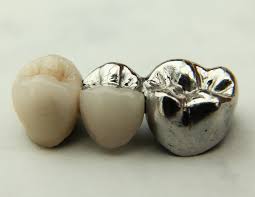A dental bridge is a prosthesis used to fix self-conscious smiles by bridging the gaps left by missing teeth. The bridge is made by placing two or more crowns on the teeth closest to the gap, these help to anchor the false tooth (pontic) in place.
Types of Dental Bridges
There are three types of dental bridges available: traditional bridges, cantilever bridges, and resin-bonded bridges (Maryland bonded bridge).
The most common form of dental bridge is the traditional bridge, which involves creating a crown or prosthesis on either side of the missing tooth space, with a pontic in-between.
Traditional bridges can be made from ceramics or porcelain fused to metal.
Cantilever bridges are used if there are adjacent teeth on only one side of where the missing tooth gap is. This method is not commonly used today as it is not recommended in the back of the mouth, where there can be too much force on the bridge and teeth.
Resin-bonded bridges are made out of either porcelain fused to metal, or plastic teeth supported by a metal framework. This method works by bonding metal or porcelain wings to your existing teeth.
The Process
Before getting a dental bridge, you will have to make sure that you are suitable for the dental bridge treatment. Your dentist will check your oral health and your jawbone density to ensure that the procedure will go smoothly.
At your first appointment, your dentist will first prepare the teeth adjacent to your missing tooth for treatment. This includes reshaping or removing a portion of the enamel in order to allow space for the bridge to be fixed over the nearby teeth.
Next, your dentist will take impressions of your teeth in order to create a model of your mouth to ensure your bridge is a perfect fit. After this, your dentist will make a temporary bridge to wear in the meantime to protect your exposed teeth and gums.
Once your bridge has been made, you will be contacted by your dentist to return for a second visit and have your bridge installed.
There may need to be repeat visits to ensure that the bite and fit are perfect. If the dental bridge is fixed, your dentist may cement it in place temporarily to make sure that it is a proper fit.
Why You Should Get a Dental Bridge?
When we lose a tooth, back teeth start to move forward, tilting into the gap and after a few years you may end up with tilted teeth (which in severe cases can be almost horizontal).
These teeth are not functional and eventually will be lost, so losing a tooth is bad but the consequence of an untreated gap may be worse.
A missing tooth can impact your ability to chew and speak, so a dental bridge will help improve your ability to dictate and to chew.
In addition to this, dental bridges are also fairly easy to care for in the long term. They are treated like just a regular tooth in the sense that brushing twice a day will increase your bridge’s life span, potentially lasting you for over ten years.


